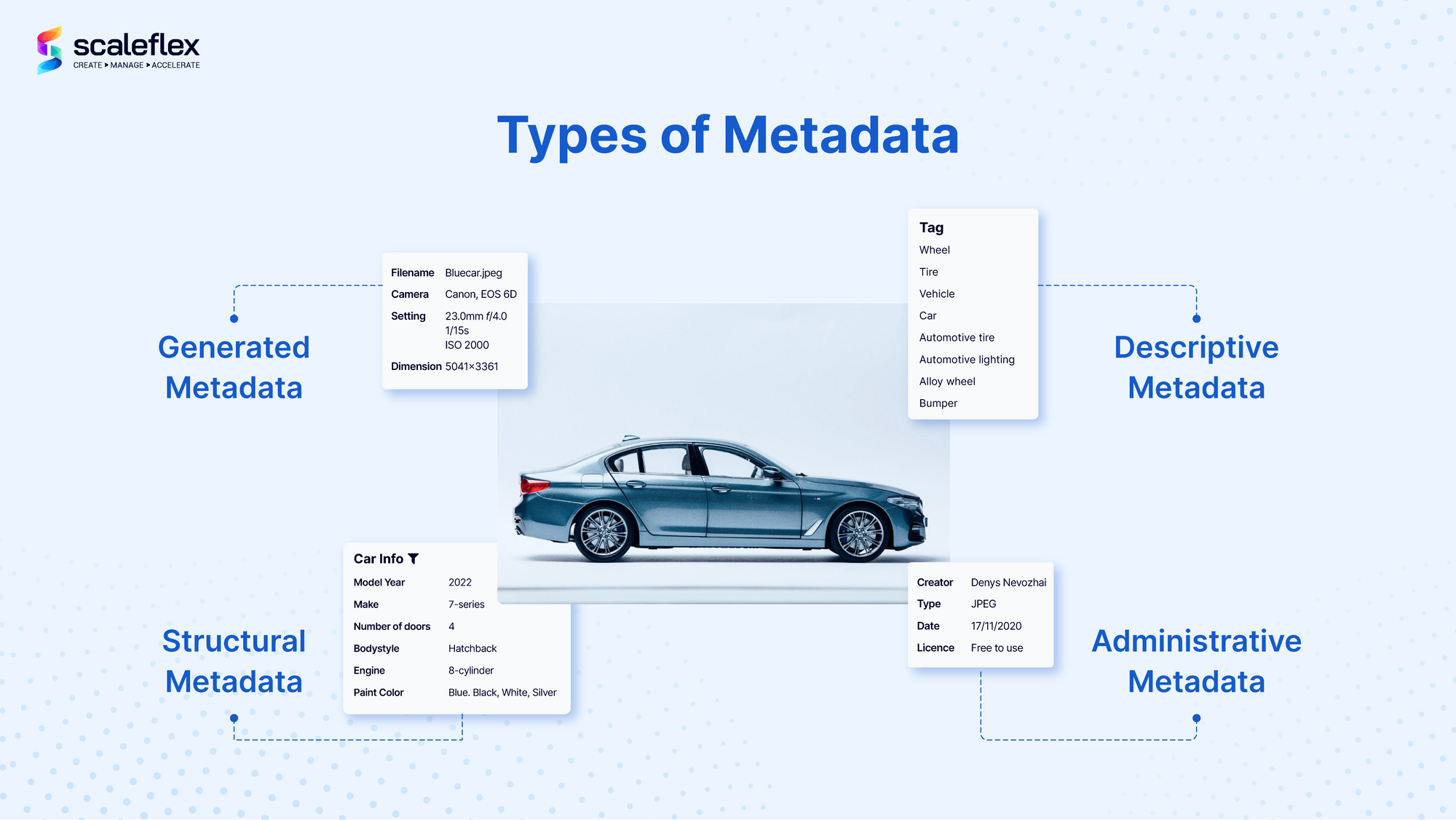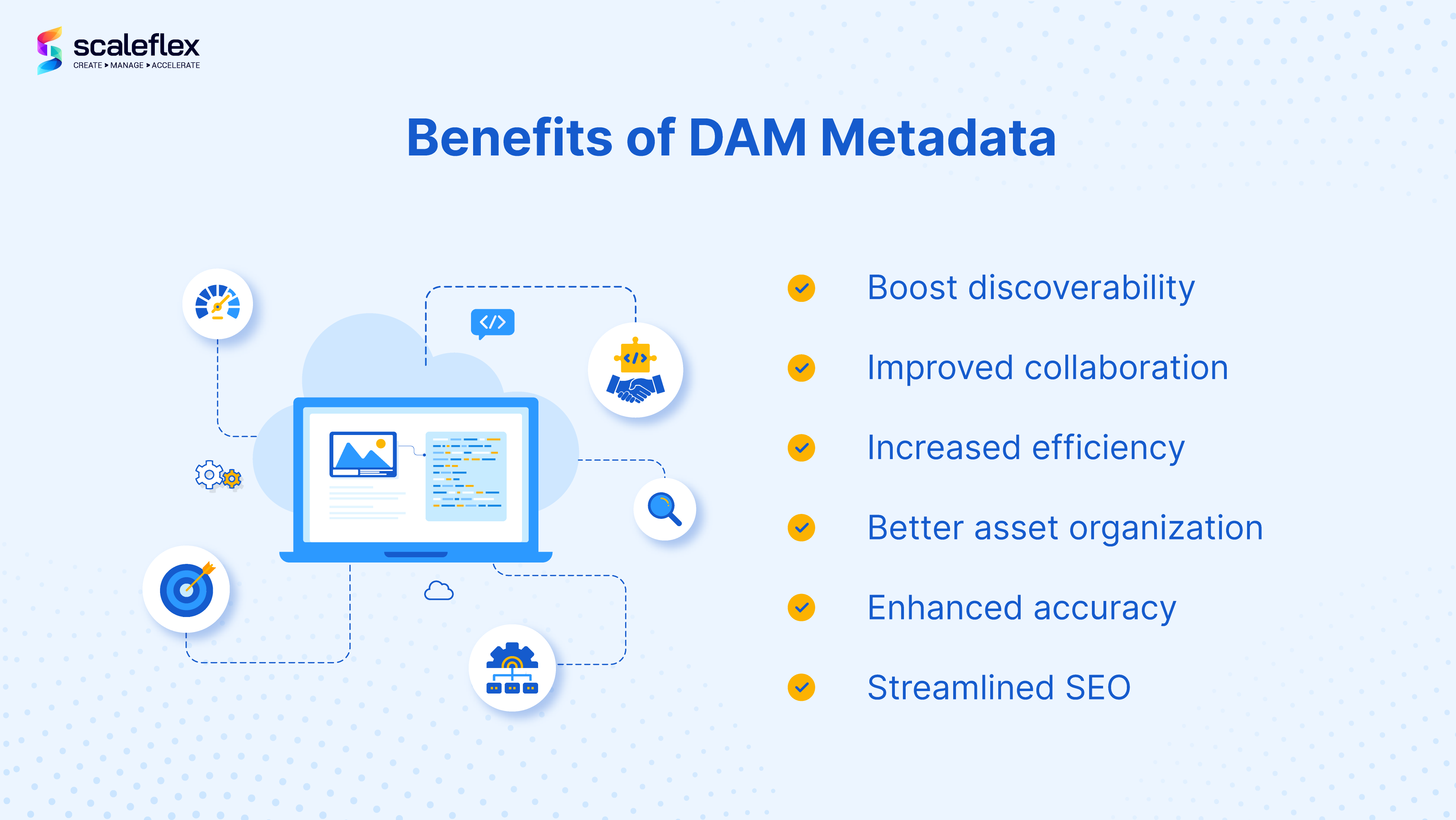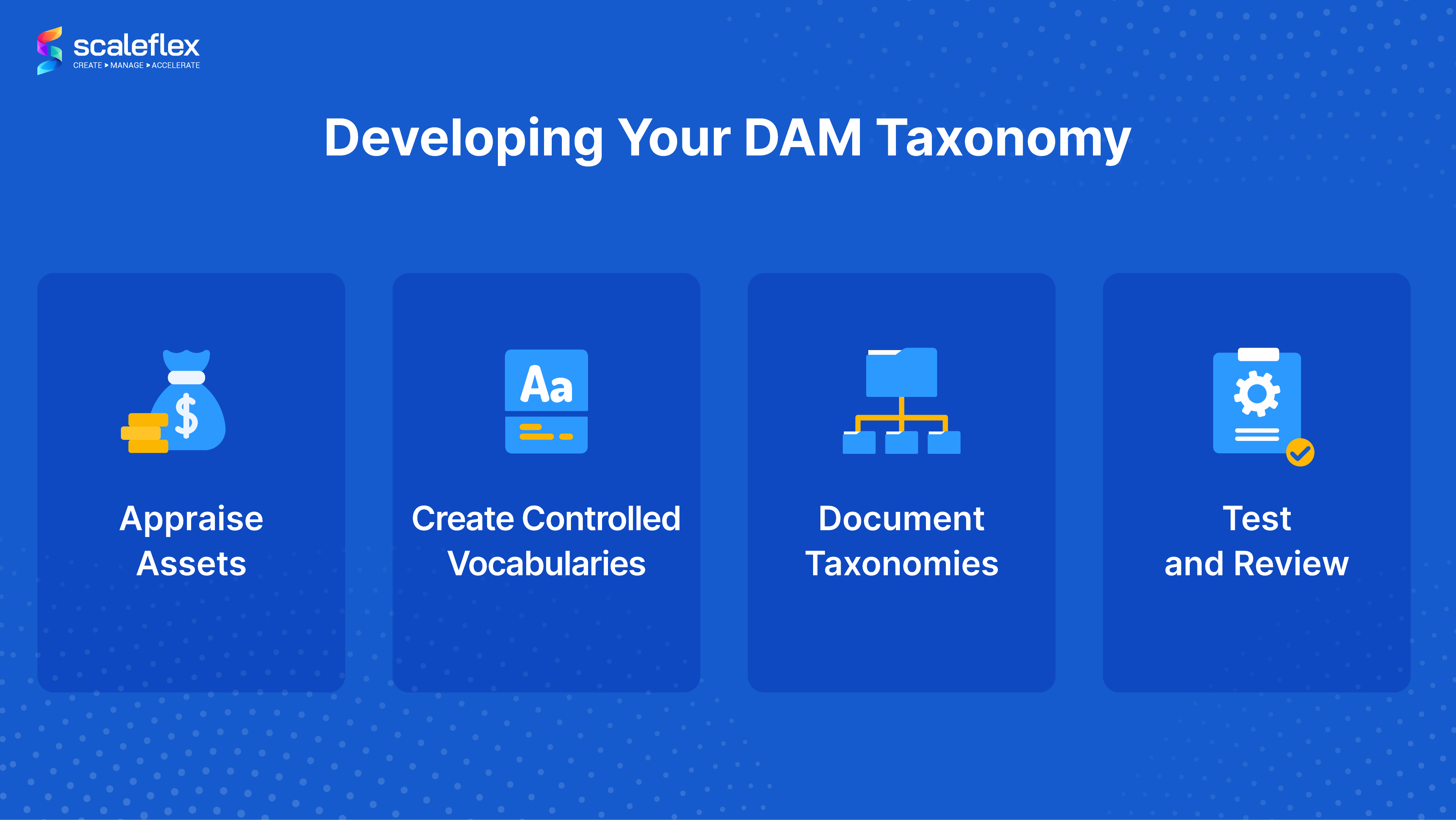The Importance of DAM Metadata: Enhancing Search and Organization
Are you tired of wasting hours searching for that one file you need? Or struggling to keep track of the latest versions of your digital assets? Whether you're a content creator, marketer, or designer, we've all been there. It's frustrating, time-consuming, and can be detrimental to your productivity.
But what if we told you that there's a solution that can help you find your files in seconds, streamline your workflows, and improve your overall organizational efficiency?
In Digital Asset Management (DAM), metadata is critical in ensuring that assets are organized, searchable, and reusable. Metadata is the driving force behind a mighty DAM. It enhances the searchability and organization of your digital assets and can help you unlock their true potential, taking your creative processes to the next level.
In this blog post, we’ll explore the importance of DAM metadata and how it can streamline your workflows, improve collaboration, and save time and money.
What is metadata?
Metadata, in simple terms, is essentially data about data, and it provides valuable information about an asset's characteristics, content, author, creation date, file type, size, location, and usage rights. These data points may be incorporated into the file or asset itself or included in a separate area like a spreadsheet or an AI-powered DAM platform.
In Content Operations, Metadata is equally essential as the actual asset itself! Effective use of metadata can make a colossal difference in the efficiency of a DAM system, making it easier for users to find the right assets quickly and avoid duplicate files. Especially in the case of visual content like images, videos, audio, and 360 images, metadata tagging enhances the discoverability of these assets by associating them with relevant context and information. Without such metadata for organizing digital assets as part of the content lifecycle management, the assets may be lost forever in cloud storage and hard drives!
What's important to note is that metadata doesn't just make information searchable for humans, but by machines as well! Think of Google search bots for improving your site's SEO. That's why learning more about how metadata works alongside asset management is important.
What are some examples of Digital Asset Management metadata file formats?
Metadata can be stored in various formats, and each has its own rules and guidelines for organizing and structuring metadata. Here are some examples of how different metadata formats are used:
- Extensible Markup Language (XML): XML is widely used in web development and is often used to store metadata for digital assets. XML is versatile and can be customized to fit the specific needs of an organization. For example, an e-commerce website could use XML to store metadata for product images, including information about the product name, category, and SKU.
- International Press Telecommunications Council (IPTC): This metadata format was developed by the IPTC format specifically for the news industry. IPTC metadata is used to store information such as the headline, caption, and author of the news article or photograph.
- Exchangeable image file format (EXIF): This metadata format is commonly used in digital cameras to store information about the settings used to capture an image. EXIF metadata can include technical details such as the camera model, aperture, ISO, and shutter speed.
- Extensible Metadata Platform(XMP): Adobe developed this metadata format, which is commonly used in Adobe software such as Photoshop and Lightroom. XMP metadata can be used to store information about the creator of a digital asset, copyright information, and descriptive information such as keywords and captions.
Using a standardized DAM image metadata format can make sharing and managing digital assets easier across different systems and platforms.
Return to the Table of ContentsWhat are the different types of metadata?
Metadata can be classified into different categories depending on its purpose and scope. Understanding the different types of metadata is crucial for effective digital asset organization.

Generated metadata
This type of metadata is typically automatically generated by the system or software used to create or manage the digital asset. Think of how a camera creates timestamps or the GPS coordinates of where the photograph was taken.
Generated metadata can include information about the file format, resolution, and other technical details of the digital asset.
Structural metadata
Structural metadata then describes the organization of the asset and how the different sections of the assets are related to each another. It is the most significant category of metadata you can contribute to a digital asset and most top DAM providers offer it.
With structural metadata, you can create your own asset organization taxonomy and categorize assets in ways that are unique to your company, as opposed to generated or inherited metadata which you have very little control over.
A structural metadata example could be how e-commerce businesses create metadata relating to the sizes of clothes (XS, S, M, L, XL), its color variants (blue, red, yellow), and even the type of apparel (shorts, jeans, shirts, t-shirts, etc).
Descriptive metadata
Descriptive metadata provides information about the visual content of the asset. It includes data such as the subject, keywords, description, and other relevant information that helps users identify and locate the asset. Descriptive metadata is key for the discoverability and searchability of digital assets.
For example, if you have an image of a blue car, descriptive metadata tags such as “wheel”, “motor vehicle”, “tire”, “car”, and more.
Administrative metadata
This final type of metadata contains information about the asset's technical characteristics, ownership, and usage rights. Administrative metadata can include file type, file size, date created, copyright information, and other technical details. This type of metadata helps ensure the management and use of digital assets and compliance with legal and ethical standards.
Photographers and agencies may want to associate metadata relating to licensing and usage rights (such as royalty-free, rights-managed, right-enhanced, creative commons) and categorize if the images are NSFW (Yes or No). Tag these media with notifications and alerts so you and your teams won't accidentally misuse them!
What are the benefits of DAM metadata?
Metadata is crucial to effectively managing digital assets, and its benefits extend far beyond just organizing and categorizing content. In this section, we'll explore the various benefits of metadata in Digital Asset Management, from enhanced searchability and discoverability to improved workflow efficiency and collaboration. We will dive deeper into how metadata can provide more value to your digital assets and, ultimately, to your business.

Boost discoverability
Metadata enables users to search and locate specific digital assets quickly and efficiently. No more going through numerous folders to find a single asset. By tagging files with descriptive keywords and categories, users can easily filter through vast amounts of content to find the exact assets they need, saving time and effort.
Improved collaboration
Metadata also facilitates collaboration among team members by providing clear and consistent information about assets. When everyone has access to the same metadata, all team members are on the same page regarding an asset's usage rights, version history, and other vital details. This also prevents any legal troubles in terms of usage.
Increased efficiency
Using metadata in Digital Asset Management can significantly increase productivity and efficiency. With proper tagging and categorization, assets can be retrieved and shared quickly and seamlessly, eliminating the need for tedious manual searches.
Better asset organization
With metadata, digital assets can be organized and categorized based on different criteria, such as file type, size, and usage rights. This organization ensures that assets are stored logically and consistently , making it easier for users to find and use them.
Enhanced accuracy
Metadata also helps ensure the accuracy of asset information, reducing the risk of errors and miscommunication, especially when AI generates and tags metadata. By providing standardized and consistent information, metadata helps maintain asset integrity and ensures that all team members work with the correct file versions.
Streamlined SEO
When you provide your photographs, videos, and other digital assets with the right metadata, you can use it to optimize your web content. Image SEO and Video SEO thrive on metadata tagging, making your media content crawlable and understandable for Google.
Return to the Table of ContentsWhat are some of the DAM metadata best practices?
Now that you know how the use of metadata in Digital Asset Management provides a range of benefits that help organizations effectively manage their digital assets, collaborate efficiently, and streamline their workflows, we’ll take a look at the Digital Asset Management metadata best practices.
Develop a metadata taxonomy and schema
Before even implementing metadata, developing a metadata taxonomy and schema unique to your organization are important. For example, some terms used only within your company or industry may not necessarily be universal. This schema should include controlled vocabularies, the specific metadata fields that are relevant to your assets, and the format in which the metadata is to be entered.

To develop your DAM taxonomy, your DAM manager will need to:
1. Appraise assets: This involves identifying the scope of the DAM system and auditing all relevant folders and drives.
2. Create controlled vocabularies: Each field should have simple and understandable vocabularies specific to your organization. For example, it might be necessary for automotive companies to refer to "rims" and ""tires and not just simplify them as wheels.
3. Document taxonomies: The next step involves translating all the metadata fields that can list the terms with operational definitions.
4. Test and review: Finally, it is time for testing and reviewing. With this DAM taxonomy, do your users find it much easier to search for digital assets? If not, perhaps there could be commonly-used terms that you’ve missed out and it is time to add that to the list!
Consistency is key
Next up, metadata application consistency is crucial to any DAM system's success (as in all other organizational matters). This means using standardized terminology and ensuring that metadata is entered the same way across all assets. Such consistency is essential for any size of business so that every team member is on the same page.
Make metadata entry mandatory
Another best practice is to make metadata entry compulsory for all assets in your DAM system. Just like how you fill in an online form and see those fields marked with an asterisk? Implement mandatory fields like these too when your users upload files! This will ensure all assets are searchable and easily accessible to all authorized users.
Train users
It's important to train all users on the importance of metadata and how to enter it properly in the DAM system. This will ensure that all metadata is entered correctly and consistently.
Such processes are so important - similar to how new employees go through onboarding in the "way of doing things in a company", this needs to be a process that is briefed, explained, and enforced in a company.
Keep it simple
While having a comprehensive metadata schema is important, it does not mean you have to come up with complex terminologies or numerous variants of the same word. It is essential to keep metadata schema simple! Include only a few fields (and only the most important ones should be made mandatory), or create a complex schema that will discourage users from using DAM metadata!
The thing about Digital Asset Management is that it is meant to make your team's lives easier. Especially for enterprise metadata management, your assets and metadata can accumulate fast, and an efficient process can help you. That is why automating such metadata tagging can be very useful, helping you save lots of time while ensuring that all essential metadata is in place!
Review and update metadata regularly
Finally, you should review and update the metadata in the DAM system to ensure that it remains relevant and accurate. For example, new concepts like "AI-generated images" may emerge, and there might now be a need to include such metadata tags in these images.
As in all things, it's much easier to do them in bite-size than to consolidate them to do it all at once! Doing so ensures that all your company’s digital assets in the DAM are continually searchable and discoverable over time.
By following these DAM metadata best practices, your organization can effectively implement metadata in your DAM system and realize its full potential, such as improved searchability, increased productivity, and better asset management.
What are the key takeaways?
All in all, metadata plays a crucial role in Digital Asset Management. Using industry-standard metadata formats like XMP and IPTC can improve interoperability and facilitate the exchange of information across systems. By using descriptive, structural, administrative, and generated metadata, organizations can streamline their workflows, improve collaboration, and maximize the value of their digital assets.
Incorporating DAM metadata best practices, too, can ensure consistent and accurate metadata across assets, helping your company optimize the metadata management and the organization of digital assets and gain a competitive advantage in today's fast-growing digital landscape.
We welcome you to discover Filerobot Digital Asset Management, a modern DAM packed with DAM AI metadata tagging features and customizable metadata fields. There’s no longer a need to manually implement all the best practices when you can leave it all to us! Save time and gain advanced DAM search functionalities with Scaleflex. Request a non-obligatory demo with our DAM experts now.
Return to the Table of Contents




